by Sheila Dunning | Dec 7, 2016
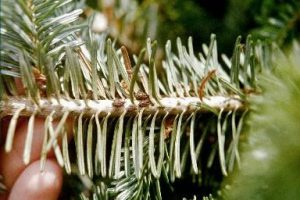 Christmas is coming. So much to do. Picking out the perfect, fresh-cut tree is one of the important
Christmas is coming. So much to do. Picking out the perfect, fresh-cut tree is one of the important 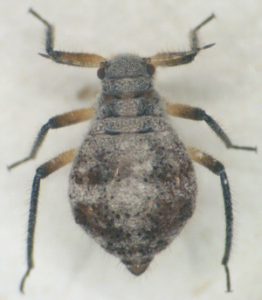 tasks. Every family member has their specific requirement. “It has to be a certain species.” It has to be a specific height and shape.” And, of course, “It has to smell great.” So, a decision is made. The perfect tree is toted home, put up and beautifully decorated. A week later, mom shrieks, “There’s ticks all over the living room!” Don’t panic. Upon inspection, you will discover that the bugs coming from your “perfect” Christmas tree are Cinara aphids.
tasks. Every family member has their specific requirement. “It has to be a certain species.” It has to be a specific height and shape.” And, of course, “It has to smell great.” So, a decision is made. The perfect tree is toted home, put up and beautifully decorated. A week later, mom shrieks, “There’s ticks all over the living room!” Don’t panic. Upon inspection, you will discover that the bugs coming from your “perfect” Christmas tree are Cinara aphids.
Cinara are a group of several species of large brown or black aphids that feed on conifers including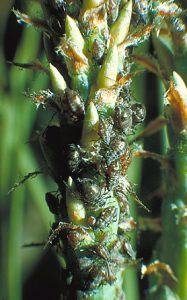 all pines, spruces and firs. When the Christmas trees are cut at the farm and bundled for shipment, the aphids get trapped. With warmer temperatures indoors, the aphids become active. Infestations may also arise from overwintering eggs that hatch. As the tree dries out, the aphids crawl from the tree into the rest of the house.
all pines, spruces and firs. When the Christmas trees are cut at the farm and bundled for shipment, the aphids get trapped. With warmer temperatures indoors, the aphids become active. Infestations may also arise from overwintering eggs that hatch. As the tree dries out, the aphids crawl from the tree into the rest of the house.
No worries. Cinara aphids only feed on conifers, so they pose no threat to other plants. They are not a danger to people or pets either. But don’t get rid of them by smashing them. You may be left with a nasty purple stain to have to clean up. Instead, pull out the vacuum and suck them up.
So, if you are one of those people still shopping for the “perfect” tree, add a preemptive strike to your decorating procedure. Unbundle and shake, shake, shake that tree outside before bringing it in. Then the only shrieking going on will be when mom opens the fabulous present you gave her.
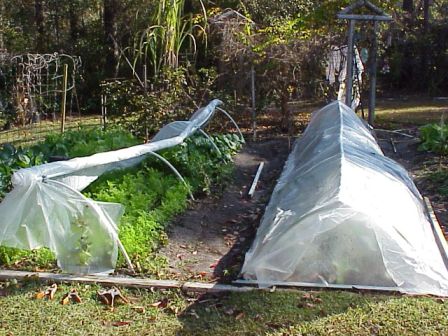
by Matthew Orwat | Dec 2, 2016
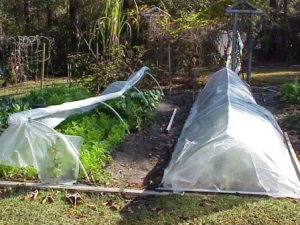 In Northwest Florida gardeners are fortunate since it is possible to grow ample supplies of vegetables throughout the winter months. While the Florida Panhandle does receive the occasional hard freeze, many winter vegetables such as radish, onion, lettuce, carrot and the various cole crops, can easily withstand mild freezes.
In Northwest Florida gardeners are fortunate since it is possible to grow ample supplies of vegetables throughout the winter months. While the Florida Panhandle does receive the occasional hard freeze, many winter vegetables such as radish, onion, lettuce, carrot and the various cole crops, can easily withstand mild freezes.
When a hard freeze occurs, defined by temperatures that dip below 28°F for over five hours, it is important to be prepared with frost cloth, cotton sheets or other suitable material. Frost cloth is a good option since it protects plants from morning frosts while still allowing for a little air transfer. It is a synthetic fabric which offers 4-8 degrees of protection and is available through many online greenhouse and agricultural suppliers. Old cotton sheets, often found at thrift stores for very low cost, offer good protection from frost damage. With both of these products, ensure that the coverage extends completely to ground level with no gaps, to not allow cold air to infiltrate from the bottom.
While these methods will not provide enough protection to allow summer vegetables to be grown during winter months, it can be beneficial in reducing frost and freeze damage to winter vegetable crop.

Additional Tips:
Do not use plastic covers, since they radiate cold and heat more readily. Even if they protect the plants from the cold, they can quickly trap heat in when the sun rises and “cook” the plants.
Additionally, it is important to keep vegetables well-watered at all times, but this is especially true during frost events since moist soil holds more heat. Healthy, appropriately watered plants withstand cold stress at greater rates.
Happy gardening over the Holiday Season!
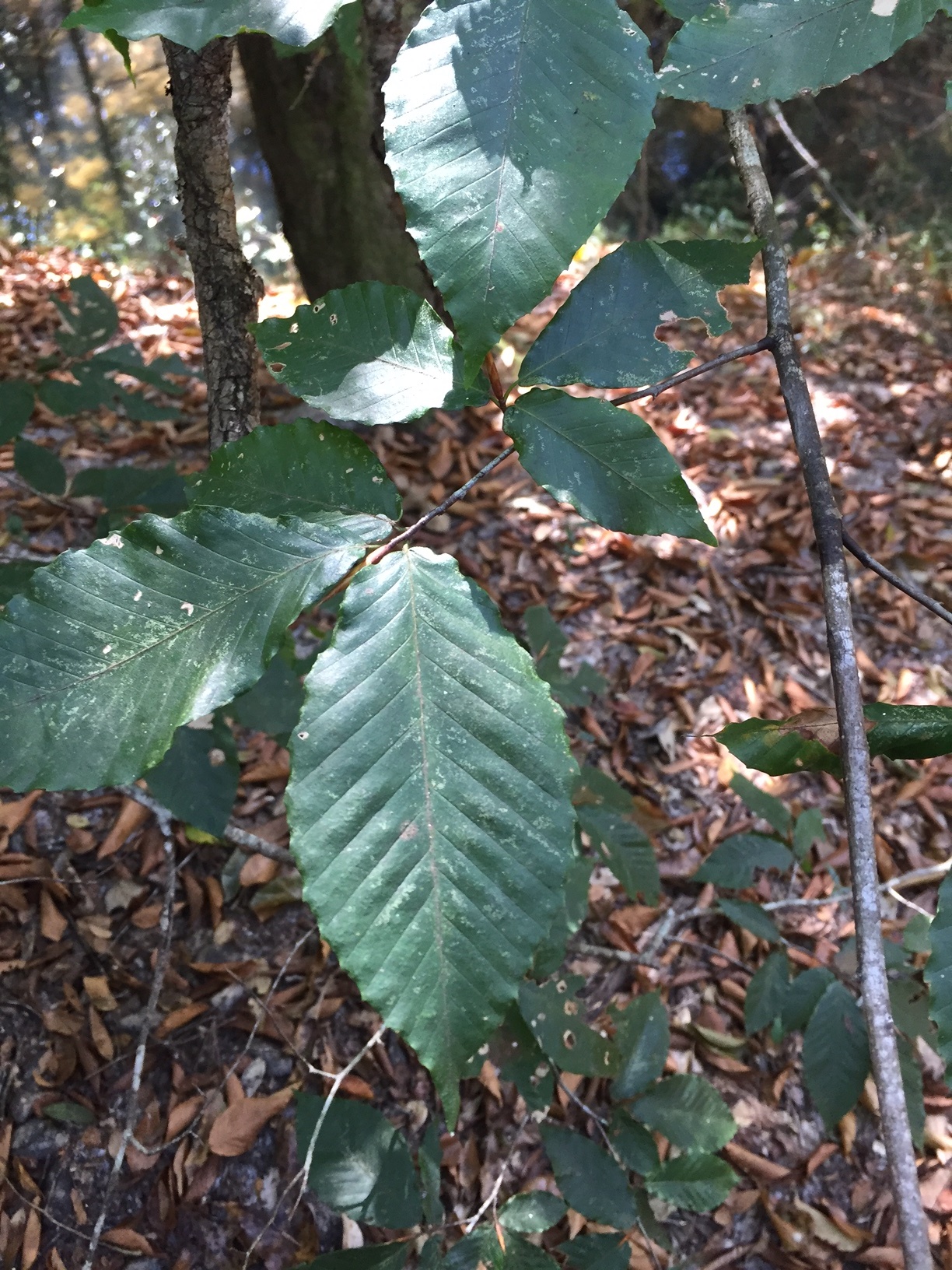
by Carrie Stevenson | Nov 22, 2016
During a recent hike through wooded property in Walton County, our Florida Master Naturalist class came across a stunning example of an American Beech tree (Fagus grandifolia). As we looked closely at its thick, sinewy trunk (often compared to an elephant’s skin), the bark changed hues from a deep red to silvery gray and brown. A hardwood, it has been used over the years to make furniture, railroad ties, and beer barrels. Like many of the local hardwood species, beech wood holds up to decay when exposed to water and early settlers used it to build mills and water wheels.

The colorful, smooth bark of a beech tree is eye-catching and strong. Photo credit: Carrie Stevenson
During the growing season, the beech tree can be identified by its distinctive dark green, tooth-edged leaves. Beeches are deciduous but have the unique quality of usually keeping dead leaves on their branches all winter, which also helps with identification in the forest.
The most fascinating observation, to me, was the series of tightly swirled branch buds ready to sprout at the tips of each new branch. So pointed that they’re easily confused as thorns, these long protrusions will eventually grow into new branches.
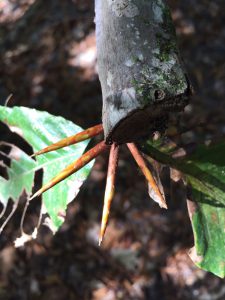
These four buds formed as an “emergency” response to the branch being cut and will eventually replace it. Photo credit: Carrie Stevenson
At the end of one branch that had been cut, the tree’s internal “emergency response” system formed four new immature branches, which had the intimidating appearance of a claw. Eventually, one of these buds will outcompete the others and grow into a new branch.
Beeches are of course known for the beech nut, eaten by humans and wildlife alike. If you’re considering a beech for a home landscape, be sure you have a wide open space with moist soil, as a mature beech can grow up to 75 feet high and 40-60 feet wide. Its low branches create a lot of shade, so understory plants are usually unnecessary or even impossible to grow.
For more information on these interesting native trees and others like it, contact your local UF IFAS Extension Office or visit the UF Landscape Horticulture page.
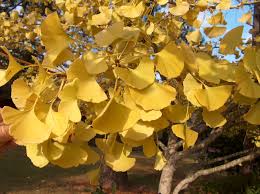
by Daniel J. Leonard | Nov 17, 2016

Ginkgo
Florida has so much to offer! It is home to the world’s most beautiful beaches. It has one of the largest agricultural economies nationwide.
But among all these things, Florida is lacking in one area that is very noticeable come fall: all the beautiful red, yellow, and orange leaf colors that paint the autumn landscape just a few hours to the north!
As frustrating as the lack of fall color in Florida’s native forests may be, this situation is easily amended in yards throughout the state by planting some autumn color standouts! Here are three of the very best for Northwest Florida:
This holdover from the Jurassic Period (Literally! Fossil records indicate Ginkgo has existed virtually unchanged for well over 100 million years!) has much to offer as an ornamental tree, including spectacular golden-yellow fan-shaped leaves in fall! Somewhat ungainly in youth, a mature Ginkgo is truly a sight to behold, an 80-100’ tall, imposing specimen. Ginkgos are very tolerant of all soil conditions except waterlogged, have few insect and disease pests, and are remarkably drought-tolerant once established. Be sure to select a male cultivar however, as female trees produce extremely odiferous seeds that remarkably resemble rancid butter!
- Chinese Pistache (Pistacia chinensis)
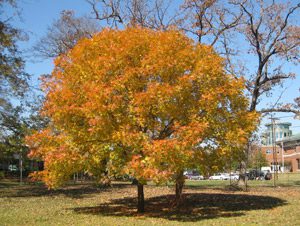
Chinese Pistache
A little-known, much underused tree in the Deep South, Chinese Pistache will light your landscape aflame with brilliant, orange-red fall foliage. One of the last trees to turn color in the fall, Chinese Pistache can help extend the show deep into November! It is a small to medium sized tree that will not overwhelm any but the smallest landscapes. As with Ginkgo, the habit of the tree in youth is awkward at best and the tree’s full potential is not realized until maturity when it becomes a dense, oval-round specimen. Chinese Pistache is close to bulletproof, tolerant of drought and poor soil conditions.
- Black Gum (Nyssa sylvatica)
One of Northwest Florida’s best native trees for fall color is Black Gum. Black Gum is a standout tree, pretty in all seasons, possessing dark, almost-black bark, a tall pyramidal habit and vivid fall foliage in the deepest shades of red and purple. As a bonus, Black Gum usually begins its color change very early, occasionally in September. The addition of this tree to a lawn dominated landscape can deliver at least an extra month of color! Black Gum prefers moist, deep soils but is found in dry flatwoods and swamps alike, betraying its adaptability.
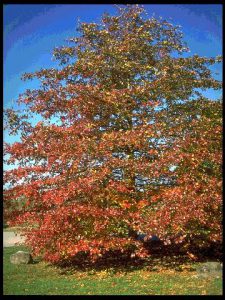
Young Black Gum Tree
Including the above trees in new or existing landscapes is an easy, smart way to extend the fall color show from September through November and make home gardeners long a little less for the colorful northern autumns! Happy Gardening!
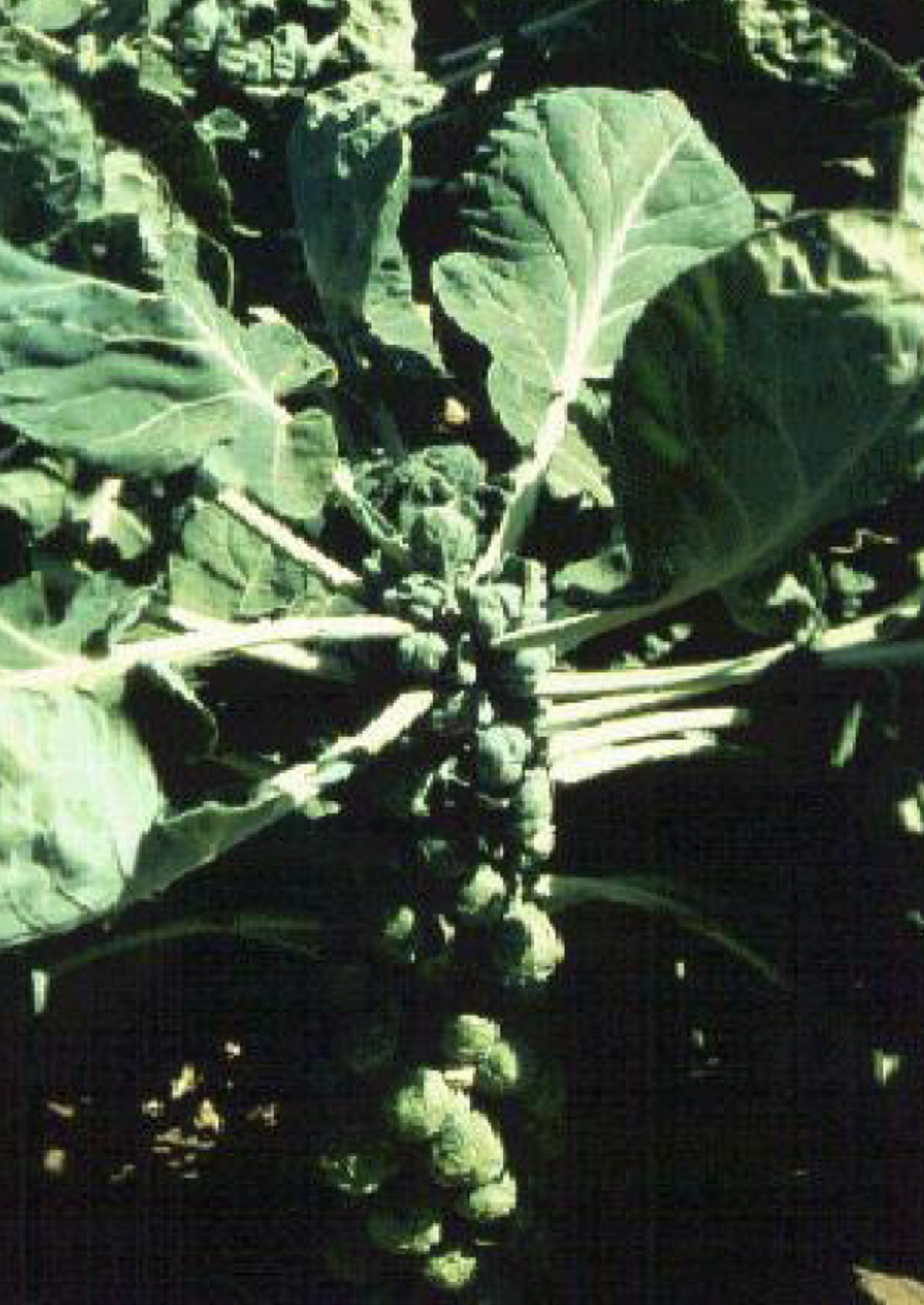
by Ray Bodrey | Nov 14, 2016
Want to try something different in your winter garden this year? Well, when it comes to Brussels sprouts, you either love them or hate them. They’re not commonly grown in the Panhandle, but if you’re looking for something different, try growing this tiny cabbage. Predicted weather conditions for this season should lend a great crop.
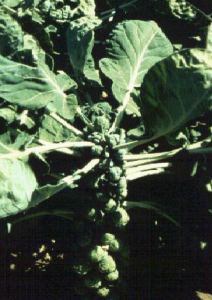 Brussels sprouts are very popular in Europe, especially Great Britain, but not so much here in the U.S. However, they are grown commercially in California and New York. But, most states have a limited market and these crops are mostly seen in backyard vegetable gardens. The two varieties, Jade Cross and Long Island Improved, are the most commonly grown in the Panhandle.
Brussels sprouts are very popular in Europe, especially Great Britain, but not so much here in the U.S. However, they are grown commercially in California and New York. But, most states have a limited market and these crops are mostly seen in backyard vegetable gardens. The two varieties, Jade Cross and Long Island Improved, are the most commonly grown in the Panhandle.
Brussels sprouts are actually a type of cabbage. However, the plant does not form one large head in the center, but rather many small heads on lengthy branches. Each golf ball size sprout resembles a cabbage head. Brussels sprouts require extended cold, dry weather, just as many sources have predicted for this year in the Panhandle. Brussels Sprouts can also survive a heavy frost. They’ll need a temperature at least in the lower 60’s in order to maintain a solid sprout and not open up. If sprouts open, structural integrity is lost, and the sprout will turn to mush.
Finding Brussels sprout transplants for your garden may be a challenge. They’re just not that popular. The good news is, seed is readily available and germination is quick once planted in garden soil. Seeds should be planted between October-December in the Panhandle. When planting, space approximately 2 ½’ apart within the row at a seeding depth of a ½”. Rows should be 2’ apart. It’s a good idea to fertilize before you plant with a general all-purpose fertilizer like 10-10-10 or 8-8-8. A good rule of thumb is to disperse 4 pounds of fertilizer per 100’ row. Once plants have grown a few inches, broadcast another application and apply a water afterwards. After a month, another application should be done. Plants should reach maturity at three months. First sprouts will develop on lower branches. Once sprouts are golf ball size, they’re ready to pick.
As far as pest management, the most common issues with Brussels sprouts are the same with any cabbage. Aphids, nematodes and cabbage worms pose the greatest threats. If these pests appear, it’s usually later in the season when the plant is closer to maturity. At that point, you should apply a common vegetable garden pesticide, one that can be used with any variety of produce. As always, be sure to follow the manufacture’s label directions when using chemicals.
Brussels sprouts are high in nutritional value. According to the USDA, a sprout has approximately 10 calories, and is high in both dietary fiber and vitamin C. Here is a challenge for readers who are not fans of the tiny cabbage. Fair warning, this challenge is under the premise that additional calories are acceptable. Start by sauteing a dozen or so Brussels sprouts in equal parts olive oil & butter. Once the sprouts have become a bit tender, add a generous amount of Parmesan cheese and bacon bits. Plate and dig in. I’m confident that this will change some minds.
For more information, contact your local IFAS Extension office
Supporting information can be found in the UF/IFAS EDIS publications, “Brussels Sprouts-Brassica oleracea L. (Gemmifera group)” by James M. Stephens, & “Florida Vegetable Gardening Guide” by Sydney Park Brown, Danielle Treadwell, J.M. Stephens and Susan Webb.
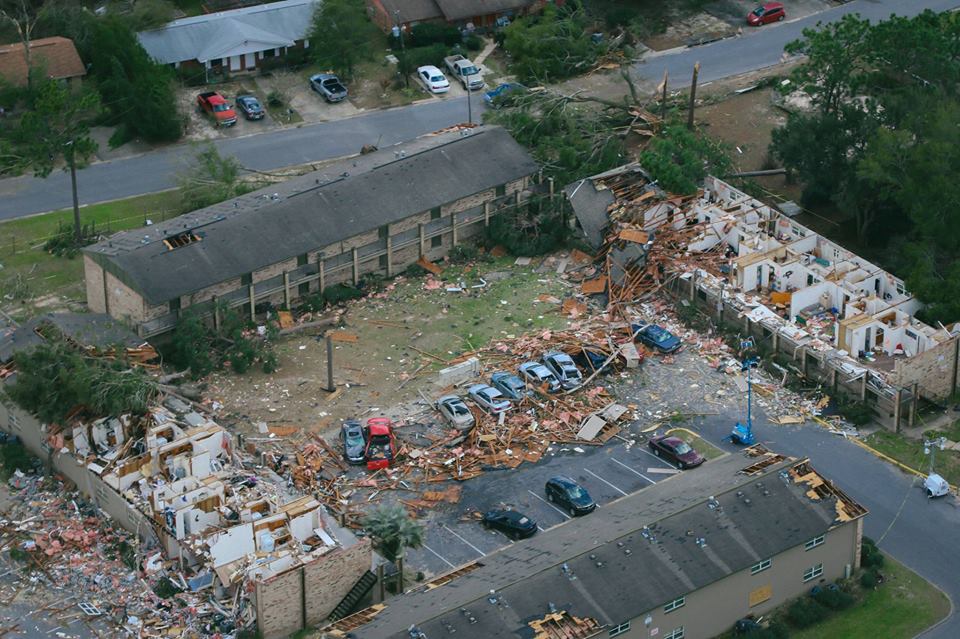
by Carrie Stevenson | Mar 2, 2016
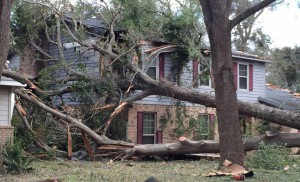
Even large, healthy oaks may fall during a tornado. Photo credit: northescambia.com
When we think of bad weather in Florida, hurricanes are typically the first thing that comes to mind. In reality, Florida is 4th in the nation in tornado frequency—and when adjusted for frequency per square mile, we are actually number 1. Residents of Escambia County are believers now, as the community reels from enduring two tornadoes in the span of a week. Both rated as EF3 storms, the winds in the twisters (136-165 mph) were nearly equivalent to a Category 4 or 5 hurricane. The western Panhandle and much of south Alabama were under tornado watches as the most recent band of thunderstorms moved through.
Based on a thorough study of surviving trees after hurricanes in Florida, there are several species of trees best suited to windstorms. For north Florida, some of the top species are: Florida scrub hickory, several native holly species, Southern magnolia, sand live oak, myrtle oak, and bald and pond cypress. Data from the full study and an in-depth overview is available from the University of Florida. To prepare for a heavy thunderstorm or a milder hurricane, it is wise to replace or plant trees with the most wind-resistant species. Because of the damage from falling trees in storms, many homeowners are nervous about planting trees. However, there are so many benefits to healthy trees in a landscape that they vastly outweigh the small risk of them falling.
Keep in mind that tornadoes are the most violent natural disasters and may cause complete devastation of homes, neighborhoods, and forests in a matter of seconds. After the Escambia County tornadoes, we witnessed large uprooted trees, downed power lines, flipped vehicles and blown-off roofs. Several homes and apartments were completely flattened or blown off their foundations. Luckily, the odds are in one’s favor of not getting hit directly by a tornado—because there’s often little anyone can do for a landscape in that situation. It’s best to hunker down in a windowless inner room or hallway, which saved the lives of hundreds during the last round of bad weather.
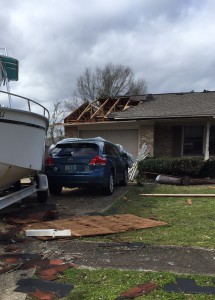
Wind entering the garage of this house may have caused the roof blowout above it. Photo credit: Carrie Stevenson
However, there’s good news that work that can be done to help protect a home during storms. Hardening homes through “windstorm mitigation” techniques can prevent updraft from strong winds. A house is only as strong as its weakest area, and those are typically the connections between the walls, roof, and foundation. A wind-rated garage door and/or brace are crucial, as strong winds can enter a garage and blow out the roof above it.
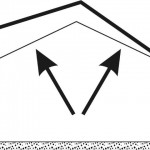
When strong winds enter a home, their force moving out can cause an updraft and lift off the roof. Graphic courtesy UF IFAS.
In Escambia and Santa Rosa County, the local nonprofit “Rebuild Northwest Florida” operates a cost-sharing program to help residents harden homes. After the tornado in Century (near the Alabama border in north Escambia County), engineers from Rebuild examined a home that suffered a direct hit from a tornado. The home had been retrofit with crucial wind mitigation techniques and sustained no structural damage. Buildings, sheds, and homes all around it were destroyed. Examples of several wind mitigation techniques, including storm shutters, wind-rated windows, garage door braces and a tornado shelter are available for public viewing at the Escambia County Extension office in our windstorm mitigation building.
As the spring storm season heats up and rolls into hurricane season, keep in mind these suggestions for both the landscape and home. As always, contact your local Extension office if you have any questions.
 Christmas is coming. So much to do. Picking out the perfect, fresh-cut tree is one of the important
Christmas is coming. So much to do. Picking out the perfect, fresh-cut tree is one of the important  tasks. Every family member has their specific requirement. “It has to be a certain species.” It has to be a specific height and shape.” And, of course, “It has to smell great.” So, a decision is made. The perfect tree is toted home, put up and beautifully decorated. A week later, mom shrieks, “There’s ticks all over the living room!” Don’t panic. Upon inspection, you will discover that the bugs coming from your “perfect” Christmas tree are Cinara aphids.
tasks. Every family member has their specific requirement. “It has to be a certain species.” It has to be a specific height and shape.” And, of course, “It has to smell great.” So, a decision is made. The perfect tree is toted home, put up and beautifully decorated. A week later, mom shrieks, “There’s ticks all over the living room!” Don’t panic. Upon inspection, you will discover that the bugs coming from your “perfect” Christmas tree are Cinara aphids. all pines, spruces and firs. When the Christmas trees are cut at the farm and bundled for shipment, the aphids get trapped. With warmer temperatures indoors, the aphids become active. Infestations may also arise from overwintering eggs that hatch. As the tree dries out, the aphids crawl from the tree into the rest of the house.
all pines, spruces and firs. When the Christmas trees are cut at the farm and bundled for shipment, the aphids get trapped. With warmer temperatures indoors, the aphids become active. Infestations may also arise from overwintering eggs that hatch. As the tree dries out, the aphids crawl from the tree into the rest of the house.














